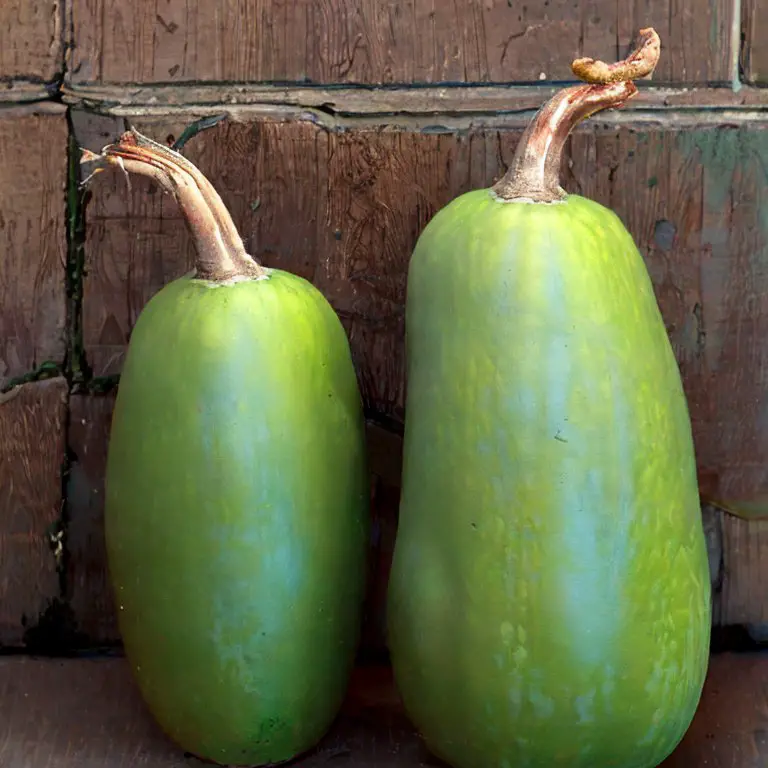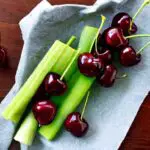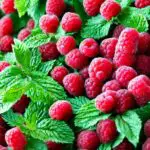
There are several fruits that start with the letter W. In this post, we will explore some fruits that start with W, along with some info for each one.
Fruits that Start with W
Watermelon
Watermelon is a large, sweet, and refreshing fruit that is native to Africa. It is typically round or oval in shape and has a hard, green rind with a red or pink flesh inside.
Watermelon is a popular summer fruit and is often enjoyed as a refreshing snack or dessert. It is high in vitamins A and C, as well as other nutrients and antioxidants that are beneficial for health.
Wolfberry
Wolfberry, also known as goji berry, is the fruit of the Lycium barbarum plant. It is native to Asia and is commonly grown in China, Tibet, and Mongolia.
The wolfberry fruit is a small, red berry that is about the size of a raisin. It has a sweet and slightly sour flavor and is often used in traditional Chinese medicine. Wolfberry is also known for its high levels of antioxidants and is often used as a dietary supplement.
The berries can be eaten fresh or dried, and are also used in teas, juices, and other products.
Wineberry
Rubus phoenicolasius, also known as the wineberry or wine raspberry, is a species of flowering plant in the rose family. It is native to East Asia, including China, Japan, and Korea, and is also found in North America as an introduced species.
The wineberry plant is a shrub that grows to about 3-6 feet tall and has prickly, arching stems. It produces clusters of small, white flowers in the spring, followed by red berries in the summer. The berries are about the size of a raspberry and have a sweet and slightly sour flavor.
The wineberry plant is often used as an ornamental shrub in gardens and is also cultivated for its fruit.
Wampi
Wampi, also known as the Guava, is a tropical fruit native to Central and South America. It belongs to the Myrtaceae family and is closely related to other fruits like the guava, feijoa, and myrtle. The wampi fruit is small and round, typically measuring about 3 to 5 centimeters in diameter. It has a thin, edible skin that ranges in color from yellow to deep red, and a soft, juicy flesh that is white, pink, or yellow in color. The fruit has a distinct, slightly acidic flavor and a sweet aroma.
In its native range, the wampi fruit is often eaten fresh or made into jams and jellies. It is also used to make juice, ice cream, and other desserts. The fruit is rich in vitamins and minerals, including vitamin C, vitamin A, and potassium. It is also a good source of dietary fiber and has been shown to have potential health benefits, such as improving digestion and lowering cholesterol levels.
In addition to its culinary uses, the wampi fruit is also used in traditional medicine. The leaves, bark, and roots of the wampi plant are believed to have medicinal properties and are used to treat a variety of ailments, such as stomachaches, wounds, and skin conditions. The fruit is also used in some folk remedies to treat fevers and other illnesses.
Overall, the wampi fruit is a tasty and nutritious addition to the diet. It is also an important part of the cultural and medicinal traditions of Central and South America.
Wonderberry
The Wonderberry or garden huckleberry, also known as the Solanum scabrum, is a plant species in the Solanaceae family. It is native to tropical regions of the Americas, and is widely cultivated for its edible fruit. The garden huckleberry is a shrub or small tree that can grow up to 3 meters in height. Its leaves are dark green and oval-shaped, and its fruit is small and round, ranging in color from green to purple when ripe. The fruit has a sweet, slightly tangy flavor and is commonly used in jams and jellies.
The garden huckleberry is relatively easy to grow and is well-suited to warm, humid climates. It prefers well-drained, fertile soil and full sun to partial shade. The plant can be propagated by seeds or by cuttings, and should be watered regularly to keep the soil moist but not waterlogged. Garden huckleberries are generally pest- and disease-resistant, but can be susceptible to fungal infections if the soil is too wet.
In addition to its use as a food source, the garden huckleberry has a number of medicinal properties. The plant has been used traditionally to treat a wide range of conditions, including fever, stomachache, and rheumatism. The fruit is high in vitamins A and C, and is a good source of fiber, potassium, and iron. It has also been used in traditional herbal remedies as a laxative and to treat digestive problems.
Overall, the garden huckleberry is a versatile and easy-to-grow plant that is valued for its delicious fruit and its potential health benefits. It is a popular choice among home gardeners and can be a valuable addition to any edible landscape.
Water Apple
Water apple is a common name for a few different plants and fruits, including:
- Syzygium aqueum, a species of tree native to Southeast Asia, whose fruit is sometimes called water apple
- Diospyros peregrina, a tree native to the Caribbean, whose fruit is sometimes called water apple
- Annona palustris, a species of tree native to the Americas, whose fruit is sometimes called water apple
Water apples are typically small, round fruits with a thin, edible skin and a juicy, translucent flesh. They are often used in salads and desserts, and are known for their crisp, refreshing flavor.
White Sapote
White sapote is a type of fruit that comes from the Casimiroa edulis tree, which is native to Central America and Mexico. It is a round or oval-shaped fruit with a green or yellow skin and a white, sweet-tasting flesh.
The fruit is often used in desserts and is known for its unique flavor, which is a combination of citrus and banana. White sapote is also sometimes called “sapote blanco” or “casimiroa.”
Winter Melon
Winter melon is a type of fruit that comes from the Benincasa hispida plant, which is native to East and Southeast Asia. It is a large, elongated fruit with a pale green or white skin and a white, crisp flesh.
The fruit is often used in soups and stews, and is known for its mild, slightly sweet flavor. Winter melon is also sometimes called “wax gourd” or “white gourd.” It is often used in traditional Chinese medicine for its cooling properties.
Wax Gourd
The wax gourd is a fruit that comes from the Benincasa hispida plant, which is native to East and Southeast Asia. It is a large, elongated fruit with a pale green or white skin and a white, crisp flesh. The fruit is often used in soups and stews, and is known for its mild, slightly sweet flavor.

The wax gourd plant is a vine that can grow up to 10 meters long. It has large, heart-shaped leaves and small, white or yellow flowers. The fruit of the wax gourd plant grows on long, slender stems and can reach up to 60 cm in length.
The wax gourd fruit has a smooth, waxy skin and a white or light-colored flesh. When ripe, the fruit has a firm, crunchy texture and a mild, slightly sweet flavor. Some varieties of wax gourd have a waxy coating on the skin, which gives the fruit its name.
To eat a wax gourd, the fruit can be peeled and sliced, and the seeds and fibers removed. It can then be cooked and added to soups, stews, or other dishes. In East and Southeast Asian cuisine, wax gourds are often used to make soups, stir-fries, and other savory dishes. They are also sometimes used in traditional medicine to treat digestive disorders and other health conditions.
Overall, the wax gourd is a versatile and nutritious fruit that is valued for its refreshing flavor and health benefits.
Wild Orange
Wild oranges are typically small, round fruits a juicy, fragrant flesh. They are often used in cooking and are known for their tart, citrus flavor.
In some cases, the term “wild orange” may refer to oranges that are grown in the wild, rather than in a cultivated orchard.
Wax Jambu
The wax jambu is a fruit that comes from the Syzygium samarangense tree, which is native to Southeast Asia. The Wax Jambu is shaped like a pear with an apple flavor containing a hint of rose. The fruit is often used in salads and desserts, and is known for its crisp, refreshing flavor.
The wax jambu tree is a large, evergreen tree that can grow up to 15 meters tall. It has a straight trunk and a dense, rounded canopy. The leaves are glossy and dark green, and the flowers are white or pale pink and have a sweet, fragrant aroma.
The wax jambu fruit has a diameter of about 3-5 cm and is typically green or pink in color. When ripe, the fruit has a firm, crisp texture and a sweet, juicy flavor. Some varieties of wax jambu have a waxy coating on the skin, which gives the fruit its name.
To eat a wax jambu, the fruit can be peeled and eaten fresh, or it can be sliced and added to salads or other dishes. In Southeast Asia, wax jambus are often used to make jams, jellies, and other sweet treats. They are also sometimes used in traditional medicine to treat digestive disorders and other health conditions.
Overall, the wax jambu is a delicious and versatile fruit that is enjoyed for its refreshing flavor and health benefits.
Some varieties have a waxy coating on the skin, which gives them their name. In some cases, the term “wax jambu” may refer to jambu fruit that has a waxy coating.
Wood Apple
The wood apple is a fruit that comes from the Limonia acidissima tree, which is native to India and Sri Lanka. It is a small, round or oval-shaped fruit with a hard, woody shell and a pulpy, fragrant flesh. The fruit is often used in traditional medicine and is known for its astringent, sour flavor.
The wood apple tree is a medium-sized, evergreen tree that can grow up to 20 meters tall. It has a straight trunk and a dense, rounded canopy. The leaves are glossy and dark green, and the flowers are white or pale pink and have a sweet, fragrant aroma.
The wood apple fruit has a diameter of about 5-10 cm and is typically green or brown in color. When ripe, the fruit has a soft, pulpy texture and a sweet-sour flavor. The flesh of the fruit is white or light-colored, and it contains several small, hard seeds.
To eat a wood apple, the fruit must be cracked open with a hammer or other hard object. The flesh of the fruit can then be scooped out and eaten fresh or used in various dishes. In India and Sri Lanka, wood apples are often used to make chutneys, jams, and other condiments. They are also sometimes used in Ayurvedic medicine to treat digestive disorders and other health conditions.
Overall, the wood apple is a unique and flavorful fruit that is valued for its medicinal properties and culinary uses.
White Mulberry
White mulberry is a type of fruit that comes from the Morus alba tree, which is native to Asia. It is a small, oval-shaped fruit with a white or light-colored skin and a juicy, sweet flesh.
The fruit is often used in desserts and is known for its unique flavor, which is a combination of tart and sweet. White mulberry is also sometimes called “silkworm mulberry” because the larvae of the silkworm moth (Bombyx mori) feed on the leaves of the tree. In traditional Chinese medicine, white mulberry is used to treat a variety of health conditions.
Other Fruits Lists
Fruits A-Z Lists
- List of Fruits from A-Z (in Alphabetical Order)
- Fruits that Start with A
- Fruits That Start with B
- Fruits that Start with C
- Fruits that Start with D
- Fruits that Start With E
- Fruits that Start with F
- Fruits that Start with G
- Fruits that Start with I
- Fruits that Start with M
- Fruits that Start with R
- Fruits that Start with S
- Fruits that Start with W
- Fruits that Start with X
- Fruits that Start with Y
- Fruits that Start with Z
- 100 Fruit Names (Most Popular Fruits in the World)
- Top 50 Fruits Names List
- Top 20 Fruit Names
- Fruits Lists A-Z
- List of Berries A-Z
- Berries Lists A-Z
Fruits and Vegetables A-Z Lists
- Fruits and Vegetables that Start with A
- Fruits and Vegetables that Start with B
- Fruits and Vegetables that Start with C
- Fruits and Vegetables that Start with D
- Fruits and Vegetables That Start With E
- Fruits and Vegetables that Start with F
- Fruits and Vegetables that Start with G
- Fruits and Vegetables that Start with I
- Fruits and Vegetables that Start with M
- Fruits and Vegetables that Start with R
- Fruits and Vegetables that Start with X
- Fruits and Vegetables that Start with Y
- Fruits and Vegetables that Start with Z
- Fruits and Vegetables Lists A-Z
Lance has been passionate about the plant-based diet and we have been following a whole food plant-based diet for over 5 years. We focus on health, natural healing, weight management, animal rights, and the health of the planet and environment by focusing on whole plant-based foods and sustainable practices.
Learn more at the About Me page and follow on social media at the links below.






